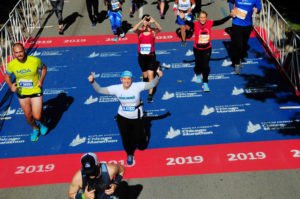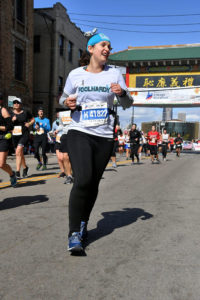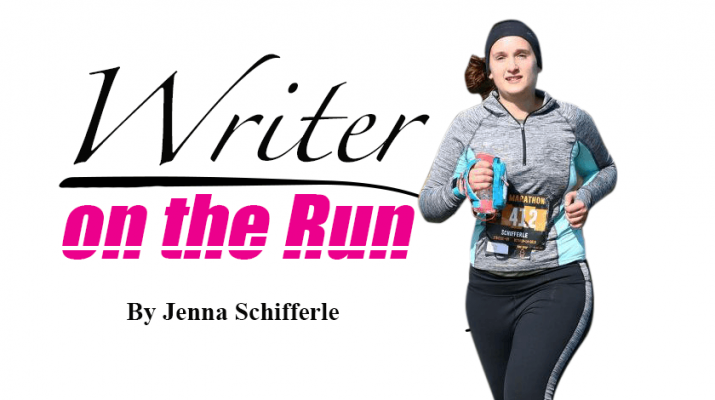Five hours, 13 minutes and three seconds. That’s what it took for Cheektowaga writer to complete the Bank of America Chicago Marathon on Oct. 13
By Jenna Schifferle
jenna.schifferle@gmail.com

At the stroke of midnight, I watched black shadows flicker against the wall. The fire alarm flashed the faintest light every 15 seconds. I counted the moments that passed between bursts and checked my calculations again … and again. Outside, the wind howled as it smacked against the window of the 17th floor. The clock inched forward, and so passed the night before my marathon.
When my alarm rang at 4:50 a.m., I was on my feet, praying that fatigue didn’t claim me prematurely. I ate and changed into my race gear. My white shirt read “Foolhardy” in black and blue lettering, a nod to the October edition of this column. The word would serve as my mantra during the race, reminding me to be bold in my endeavor. I repeated the word to myself as I secured my race bib and headed out the door.
My Uber driver dropped me off a block away from the Ronald McDonald House race tent, where I stretched and drank a cup of coffee. There were hundreds of people gathered inside, and a DJ played music as our start time approached. Soon, the first wave was announced and the crowded thinned out. The rest of us waited anxiously, fiddling until they finally announced the second wave. I joined a crowd of eager runners, scurrying down the sidewalk to corral H.
Beside me, a petite brunette chattered away excitedly and shared the story of her first marathon. Her name was Melissa, and we reached the gate together, exchanging tidbits about our lives and tips for the race. Our corral was a distance from the start line, and we crowded together as we waited to toe the line. I could feel a pang of anxiety starting, and I bounced on the balls of my feet to stay moving. To distract myself, I talked to people.
A short blonde introduced herself as Crystal. She had run her first marathon over a year ago in Disney. Originally, she had intended to run the Disney Princess Half Marathon, but it got canceled. Instead, she transferred to the full marathon with little time to prepare. At mile 20, she thought she was “going to die,” until another runner put his arm around her and told her they’d finish together. Ever since, she was hooked on marathon running. Dave, another runner in our corral, was running his 16th marathon. His son lived in Vietnam and had told him that in Vietnamese culture, they don’t believe in luck. Instead, they tell people to go “with success.”
The gun went off, and for the next 20 minutes, we inched closer to the start line. People flung their extra layers of clothing on the sidelines, leaving paths on either side of us. When our feet brought us to the front of the crowd, Dave turned to me and repeated his phrase: “With success!” As my feet tapped the timing mat, he disappeared into a sea of faces, and my race began. I had made it past the start line.
People crowded the sidelines along the course, cheering from the top of their lungs. They brandished signs and waved pompoms in the air. At mile 1, I spotted them: my cheer squad. My parents and boyfriend had made the journey from Buffalo to Chicago to root for me in person, and they stood on the opposite end of the street — in front of our hotel — with a sign that said, “Go, Jenna, Go!” I cut across two lanes of runners to wave at them and tell them I loved them. They donned the same “Foolhardy” shirts, and as I passed by, we looked like we shared a secret only we understood. They screamed my name, and I kept going.
At mile 3, I made a mad dash to the bathroom inside a 7 Eleven (waiting an hour inside a start corral isn’t ideal). Luckily, the patrons let me cut, and I was in and out in three minutes. Just shy of mile 4, I spotted my cheer squad again and reminded myself not to get too excited and run faster. With so many people in one area, the GPS on my watch wouldn’t connect, so I was pacing based on good, old-fashioned feeling. I had no idea how I was doing until I reached the official timing chips.
As the miles passed, the crowd remained. Even when there wasn’t an official fuel stop, people handed out food, water, beer and even vodka. Uplifting signs and funny catch phrases were everywhere. Someone dressed up like an alpaca with a poster that read: “Run a marathon? Alpaca my bag.” When I passed the pride district, spectators performed dance routines on stage while singing their hearts out; when I passed the Hispanic district, there were Mexican flags waving and Spanish music blaring.
I cruised into the halfway point feeling strong, only a few minutes behind my average half-marathon time. Just beyond the halfway point, I saw my parents and boyfriend again. This time, I stopped momentarily to hug them, switch out the water bottles on my running belt, and take a quick group picture. My dad was beaming ear to ear as he waved another sign that read, “Halfway there!” I soaked them in for a second and then hit the pavement.
As I settled back into my pace, I noted that this would be the part of the race that hurt most. So, I decided to break it up into parts: Hit 16 miles, replicate 18, push it to 20, see what happens. My training had brought me up to 18 miles, so I knew I could do it again. Between miles 16 and 18, I reminded myself of that fact. Still, those miles dragged. Throughout the race, I’d been diligent about fueling with my gels and staying hydrated, but I needed real food. I grabbed part of a banana from an aid station and choked down some pretzels from a spectator to keep from depleting.
Finally, I hit the 18-mile marker. My timing was on pace with my training run, and I felt — dare I say it — good. So, I asked myself if I could push the point, which had originally been to replicate my training. Could I do two more miles without stopping? I was going to try. As I passed the Biofreeze station, people furiously rubbed their sore, aching muscles with cream, as the woman next to me laughed. I turned toward her, and she said, “That’s not going to help us now.” I smiled in agreement, realizing for the first time that I ached everywhere.

The 20-mile marker came and went as I made my way into Chinatown. The district was marked by a massive archway, colorful streamers and paper dragons, and the largest crowd I’d seen yet. Amidst the spectators, three foolhardy faces stood out, and I ran to them, wrapping my arms around them collectively. I didn’t know whether to fall over or laugh. My boyfriend asked me how I was doing, and my response was simple: “I’m going to finish, and then I’ll probably cry.” I didn’t know why, but I knew it was true. I was feeling the weight of exhaustion, silenced only by the triumphant awareness that I was going to finish — five and a half miles to go.
I continued on, begging myself to push the point to 21 miles. I did, and then I pushed it to 22 and 23. At the end of that mile, I walked for a minute and then kept going. At mile 24, my stomach lunged, and I took another walk break that lasted only a minute. I kept going, playing mind games to keep myself running — make it to the street sign; no, the next street sign; make it to the Burger King; push it to the mile marker.
Finally, I made it to mile 25, where I knew the only hill on the course would be waiting. When I saw it, I wanted to walk, my feet locking up at the thought of working any harder. From the sidelines, a woman shouted that the finish line was around the corner. I thought she was lying until another woman mimicked her. “Don’t stop,” they said. I decided to listen despite my body yelling and my mind wearing down. Every step hurt as I approached the top, and my lungs screamed for air. Finally, the ground evened out, and I turned the corner. There it was: the finish line.
On the sidelines, my cheer squad rallied for me. I waved with what energy I had left and decided to sprint. When you’re 26 miles into a marathon, “a sprint” looks more like an agonizing crawl and feels like it, too. Regardless, my pace quickened, and I started passing people, weaving in and out to bolt across the finish line. Moments later, I did. My feet tapped the final timing mat, and I was done. I threw my hands in the air as my feet skidded to a clumsy walk.
My marathon took me five hours, 13 minutes, and three seconds to complete. You might think that’s slow or strong or somewhere in between, but it doesn’t matter. Five years ago, I set out on a journey inspired by watching the athletes at the 2014 Bank of America Chicago Marathon. Days later, I started running with zero experience or knowledge, beyond knowing I would need to put one foot in front of the other. Along the way, I accrued injuries and setbacks while battling every doubt my mind could muster. I told myself I couldn’t more times than I can count, but I never gave up. Instead, I did what I knew and put one foot in front of the other. On Oct. 12, 2014, I became inspired. On Oct. 13, 2019, I became a marathoner.
To all my foolhardy readers, go with success. Chase whatever dreams speak to your wild hearts and trust that one step after another will get you to your finish line.
To check previous columns from writer Jenna Schifferle, where she discusses her preparation for the Chicago marathon, go to bfohealth.com and type “Writer on the Run” on the search button.

